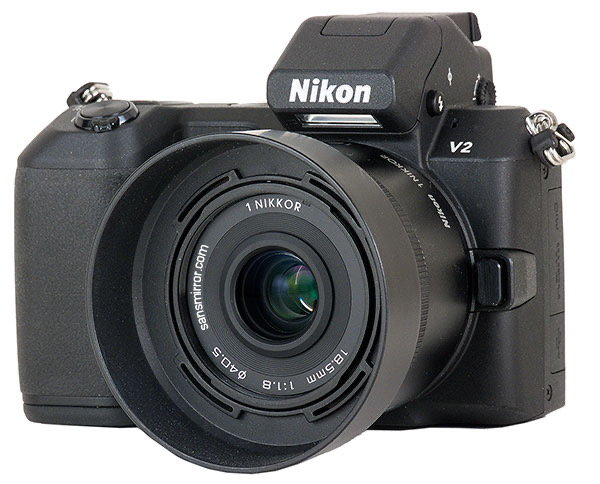
What is It?
Surprisingly, the V2 is a pretty complete redesign from the V1. While much of the internals, menus, and capabilities (Motion Snapshot, etc.) remain the same, outside it's a whole different ball game.
The V2 is a more squat camera. A little less wide, but deeper at the grip and taller at the EVF than the V1. Curiously, the actual body is a bit smaller in area and visual mass, and weighs in at 278 grams instead of 294.
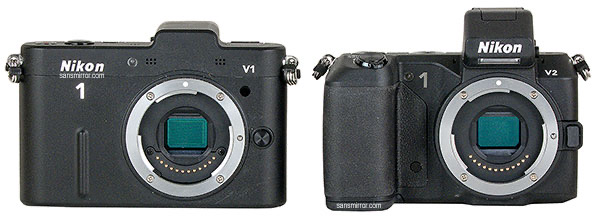
Nikon V1 at left, V2 at right
Most obvious is that the clean case and prism lines of the V1 have been replaced with a somewhat geeky camera design more reminiscent of a squarish DSLR. Some say that the new look reminds them of the old FTN SLR, but I didn't realize that was a look that anyone wanted replicated. Essentially, we get a giant cubic wart holding the EVF coupled with a small flash unit sitting on top of the body, and this is enough to make the camera no longer quite so manageable for pockets (jacket pocket, that is). You now have something that tends to hook on edges, not the more soap bar like shape of the V1. The new internal flash supports Nikon's CLS system, as you might expect, though it doesn't have a commander mode built-in (big loss, in my book).
Other obvious external changes are that the V2's accessory port goes up on top of the flash instead of alongside the EVF as it was on the V1, a real Mode dial now sits atop the camera as does a rear Command dial, the body gets a pronounced right hand grip (much like a mini DSLR), and the four buttons around the Direction pad have migrated to the left of the rear LCD.
Yet while it looks like a much different camera, much of the basics are the same, with one exception: we now have a 14.2mp sensor inside instead of the 10.1mp one. This boosts base ISO to 160. But all the other goodness of the V1 is here: 135-point phase detect focus sensors, excellent video support, both mechanical and electronic shutters that will take you to 60 fps (15 fps with focus now), the 1.44m dot EVF and 921k dot LCD, and so on. The battery is now the EN-EL21 and we're down to 310 shots/charge CIPA versus 400 for the V1 with the old EN-EL15. The V2 adds a 720P/30 video mode. One last change: we get a microphone input for video.
Looked at from a different standpoint, Nikon seems to have taken the criticisms of the V1 at heart: we have a Mode dial that stays put and works like you'd expect on a sophisticated camera, we've got a more DSLR-like handling (grip, command dial, etc.) and look (obvious prism). Why this wasn't the original V1 design, too, I don't know. While I liked the V1, it never really came off as small DSLR, while the V2 from first glance does.
Still no exposure bracketing, and for some reason interval shooting has disappeared, as has the rear IR receiver (the front one is still there).
Unfortunately, we're back to where we were with the V1 initially: it's a bit overpriced for its abilities and performance. While Nikon is running a small instant rebate as I write this, the US$800 body price doesn't come down enough to make it truly competitive with some other cameras, including some Nikon DSLRs. I'll have more to say about that later in the review.
How's it Handle?
Better. Much more like a small Nikon DSLR.

Nikon V1 at left, V2 at right
Just changing the Mode dial so that it's really a Mode dial, coupled with Nikon's signature horizontal rear command dial plus a real grip for the right hand, and a Nikon DSLR user is immediately more comfortable with the V2 than they were with the V1, where exposure modes were buried in the menus and changes were done with a vertical lever. Seems simple enough, in retrospect, doesn't it?
There are still some slight cognitive dissonances. For example, in Manual exposure mode the command dial up top controls shutter speeds, but the dial around the Direction pad controls aperture. This "feels wrong" to a long-time Nikon user, as apertures were always controlled in front of the camera, not the back. Not a terrible thing, obviously, but one you'll have to get used to: no Nikon DSLR operates this way.
The biggest handling change has to be the F button. On the V1 it was fixed in nature depending upon what "mode" you were in. Now it's a shortcut to a number of key shooting parameters: ISO, Picture Control, White Balance, Focus mode, and Metering mode. Press the F button to bring up the quick selection screen of icons. One will be highlighted in yellow. Move the highlight with the dial(s) to the item you want to select. Press the OK button or press the rear command dial forward to select it, then use the dial(s) again to make your setting. Another press of the dial or OK button and you're done. It's actually more difficult to describe than use. Think of it as a very quick menu for essential shooting parameters, and one that can be changed fast and with your eye at the EVF.
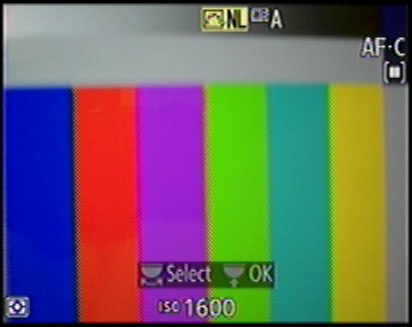
F button in Aperture exposure mode: one icon is highlighted (Picture Control here, at top), Control dial moves highlight to another item
I can't emphasize how big a change that one thing was for normal shooting in the PASM exposure modes. Whereas before the V1 was "clunky" and totally menu oriented for making almost any change, the V2 is a breeze to change during shooting. This doesn't apply quite so much to Scene exposure modes, Motion Snapshot, or Movie Shooting, though, where the F button is much like its old one-function self.
The new grip on the right side of the camera also contributes to better shooting, too. You can really one-hand the camera now, whereas before it would tend to slip out of your hand if you tried that.
I can't say that the pop-up flash is much of a pop-up. More like a "slightly move into shooting position" flash. It's so close to the lens that lighting is impaired with even the 10-30mm kit lens on the camera with the lens hood. Of course, it only has a Guide Number of 16 ft (5m), so it's not as if this is going to be your go to lighting source. If you need to get flash higher up, the accessory port will accept the SB-N5 or the newer SB-N7 flash.
How's it Perform?
When the camera was announced, I figured I'd be writing a long section about performance differences. Surprise.
Summed up: worse shots per charge, same autofocus speed, similar visual quality. So see my V1 review.
Wait, what?
The smaller battery the V2 uses means it's right down around that 300 shots/charge realm of the compact cameras. You'll want several extra EN-EL21 batteries if you're shooting all day with this camera. Personally, I was hoping for the same battery as before and more shots per charge. That's a step backward, Nikon.
The autofocus system is as it was before, despite moving to a different imaging sensor: very fast and DSLR-like in good light, some slow down low light conditions. I was expecting that the change of sensor photosite size might have an impact on the focus system, but it didn't.
Oh, it's the "similar visual quality" remark that caught you by surprise? Me too. Okay, let's see if I can explain. We gained some pixels (40% more), but I don't think we made a sensor generation change. Here's the way to think about it: if you're printing the same size, will you see a change? As it turns out, not really, especially once you're at ISO 1600 or higher*. I mean if I really get into my CIS mode and try to discern very small changes, I can find a few at the high ISO values. But physics says that if we use the same technology in the same size capture area (1" sensor) but capture in smaller pieces (more photosites) instead of larger pieces (fewer photosites), we're essentially capturing the same amount of light. When we output those to the same size (print or display), there shouldn't be a noise advantage.
*Ah yes, the footnote. There is one change that occurs: if you sample more (14mp instead of 10mp), you should get better edge acuity. At base ISO I would say that this is certainly the case on the V2 versus the V1, though there's often still a bit of roughness to the edges due to some underlying noise.
But let's go to some images and see what we see. Remember, everything you see here may or may not be scaled (images are scaled automatically by the system), and has JPEG compression in it, so you'll have to go a bit more by what I write than what I show. We're at ISO 3200, as usual.

Straight V1 image, ACR defaults on conversion, no sharpening, no luminance noise reduction

Straight V2 image, also with ACR defaults
Obviously, the V2 image is bigger than the V1 image due to the extra pixels, but is it better? No, if anything, it's visibly worse. There is more contrast buildup (darker orange) and more visible noise. When I scale the V2 image to the V1 size, though, the only really visible difference is the darker orange color. The noise/detail is relatively close.
Okay, what if I try doing some careful work on the images?

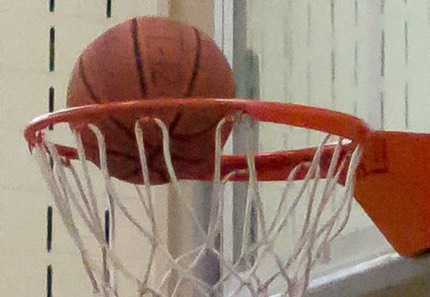
Doh! Same thing. The V2 has a slighter narrower set of colors still, but the noise cleaned up about the same on both, to the point where I can read markings on the ball (remember, I'm standing off the court, and with about 70mm in equivalent focal length). Yes, if pressed to the wall, I'd say the V2 image shows a tiny bit more detail and edge acuity. Under the circumstances, not enough to get excited about. The far bigger gain is the ability to print or output larger and get similar results to the V1. But be careful here, if you're going to crop down to 10mp, the V1 with the right lens is better than the V2 with the wrong lens that caused you to crop.
Okay, let's try something else. Here's another photo (actually this is the right half of a full V2 photo, cropped vertically, so you're looking at about 7mp worth of the 14mp capture at ISO 800:

Looks pretty good, right? Let's go in even tighter (100% pixels):
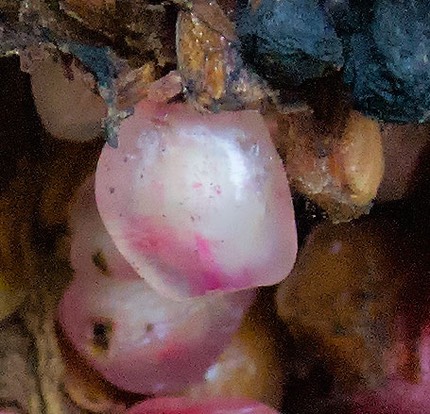
That's remarkably good. True, I cleaned it up a bit using Nik plug-ins, but the detail is holding pretty well. Look at the noise in the background (this is ISO 800): it's there, and it's actually been sharpened a bit, which makes it more visible, but it's almost like film grain in its visual impact. This is the same personality I found with the V1 sensor, as well: the lenses and sensors of the Nikon 1 models are well matched and resolve well, and as noise appears, it does so gently at first. Once you have to suppress color noise at the higher ISO values, though, we get that much more ugly noise rendering and lose edge definition.
Overall, it really does feel like Nikon managed to maintain the look and feel of the V1 results but just give us some more pixels. Both cameras tend to break down around ISO 1600, and by ISO 3200 you'll need very careful processing to keep noise and edge destruction in check, plus you'll be struggling to pull colors back to their real values.
But at base ISO, the V2 shines, and I'm not afraid to push it out to ISO 800 if need be.
Final Words
Unfortunately, Nikon doesn't make this easy. The problem with the V1 was that it cost too much for what it delivered. The problem with the V2 is that it costs too much for what it delivers, plus those that picked up a V1 during the fire sale probably would rather be spending their money on more lenses, not a replacement body. Had these both been US$600 camera kits at launch, it would be a no brainer to recommend them.
The shame is that the V2 is just a better daily shooter than the V1, almost solely due to the few changes in user controls. A DSLR shooter isn't going to have any trouble with the V2 in use; they'll feel right at home. Cut down camera, cut down controls, but the balance is just right with the V2, where it was completely out of whack with the V1. The addition of a built-in flash is interesting, but I'm not finding it terribly useful for other than some posed candids (how's that for an oxymoron?).
Now that we've got a few interesting lenses for the Nikon 1, I want to like the V2 more than Nikon lets me. Consider someone trying to build a basic V2 kit from scratch: V2 body, 10-30mm, 30-100mm, 10mm, 18.5mm, 6.7-13mm lenses plus an FT-1 sets you back US$2000 at Nikon's current prices. Yes, you'd have a versatile small system, but is the value really there? It's difficult to say yes. Knock US$300 off the body cost and skip the 10mm, and we'd be at a more reasonable US$1500. Of course, even US$1500 will buy you some pretty darned good DSLR gear, so even then the value proposition would be tough to justify.
That said, I continue to like shooting with the V1 and especially now the V2. It also goes to show you how much time changes things. The V2 is easily at the D80 level of capability in my opinion, but a complete V2 kit almost fits in my laptop case (with the laptop). Can't say that about any of my DSLRs. So here we have something six years later (than the D80) that is a miniature version with almost all of the goodness (actually more goodness in some areas, such as frame rate, video, pixel count, even the focus system). It's funny how time distorts value equations, though. What we expect at this price point is more than the V2 delivers, other than small size, which it delivers in spades.
As you might be able to tell, I'm a bit conflicted. I have to confess that I'm doing a fair amount of casual shooting with the V2, especially now that we have a wide angle lens for it. On the other hand, the price makes it hard to recommend. So let me try a different approach.
Buy a V2 or a:
- m4/3 camera. As long as you don't value continuous focusing, you might find a lower cost m4/3 body you like that performs as well in image quality and has that huge m4/3 lens selection to choose from. But V2 versus OM-D E-M5? While it's much closer than you might think, the Olympus is going to win that by being a more complete camera for not much more money. Nikon just can't quite seem to make a Nikon 1 model that is going to truly top the nearest equivalent m4/3 (e.g. J3 to E-PL5). That's one of the things that makes me back off the value rating.
- Sony NEX. The NEX-6 is going to give the V2 a run for the money, as you'll see when I post that review. In terms of size, they're similar (though the NEX-6 doesn't have the viewfinder hump the V2 does, which makes it look a bit smaller). I'd have thought that the 16mp APS sensor would truly out run the V2's 1" sensor, but as it turns out, Nikon seems to extract more than expected from their small sensors, and Sony is still extracting less than I expect from the larger sensors. That narrows things a bit, and the Sony is US$150 more, but this is a lot like the V2 versus OM-D, only closer. I could go either way here, but most people would probably find more value in the Sony (tiltable LCD, WiFi, applications, more pocket friendly profile, some additional features the Nikon doesn't have).
- small DSLR. This is where things get ugly in pricing. You pay for size of camera with the V2. But you can get supremely competent and fully featured 18-24mp DSLRs for the money you'd put into a V2. You have to want the smallness of the V2 and be willing to give up image quality and features to get it.
- versatile compact. The Sony RX-100, Canon G1x, and even the Coolpix P7700 come to mind. But none of those shoot like a DSLR, none have anything approaching the focus system the V2 has, and none are as versatile as an interchangeable lens camera.
Bottom line is this: the V2 still feels high in price. Just like the V1. Nikon didn't deliver quite enough new goodness to justify the price. Don't get me wrong here, I'm not talking about sensor. The 1" sensor continues to perform a bit out of league, so that's actually not the weakest link on the V2. Why'd we lose the intervalometer, Nikon? What you really need to do to justify the price is make sure the V2 is a true smaller DSLR. At this price I expect more of your DSLR features: interval time shooting, time-lapse, real-time histogram, flash commander mode, bracketing options, panorama mode, save/load settings, and so on. But we seem to be going the other way, trimming stuff out.
So I come to the same conclusion I did with the Nikon J1 and V1: nice effort, makes nice pictures, has state-of-the-art focus system, but priced wrong to get people to buy it. That's a shame. Because the V2 is actually a fairly nice camera to shoot with, and the new lenses are quite good while staying small.
And then there's the wildlife photographer that Nikon never seems to see: with the F-mount Nikkors and the FT-1 adapter, the V2 is nothing short of amazing: 14mp handheld images at 810mm equivalent that stand up great (as long as you don't push that ISO too high). Wait, 810mm equivalent? Yeah, you'll get that from the 28-300mm, 55-300mm, and 70-300mm F-mount lenses (latter preferred). Sure, you'll have to adjust your focus techniques a bit, but even single shots of BIF (birds in flight) are possible with practice. With the new 80-400mm, we're now at 1080mm equivalent. Holy smoking gun, Batman!
Thus, I have reason to want to like this camera. I'm bringing it to Botswana with me for the reason just hinted at. Sure, my big boy DSLRs have got the 70-200mm and 200-400mm on them, but sitting right next to me is that V2 with the 70-300mm for when I need to go long.
But is it for you, that's the question. Well, if the Nikon V1 wasn't for you, the Nikon V2 probably isn't for you, either, simple as that.
2018: this model is out of production and no longer available new. But used copies can easily be found.
Support this site by ordering your V2 camera from the following advertiser:
